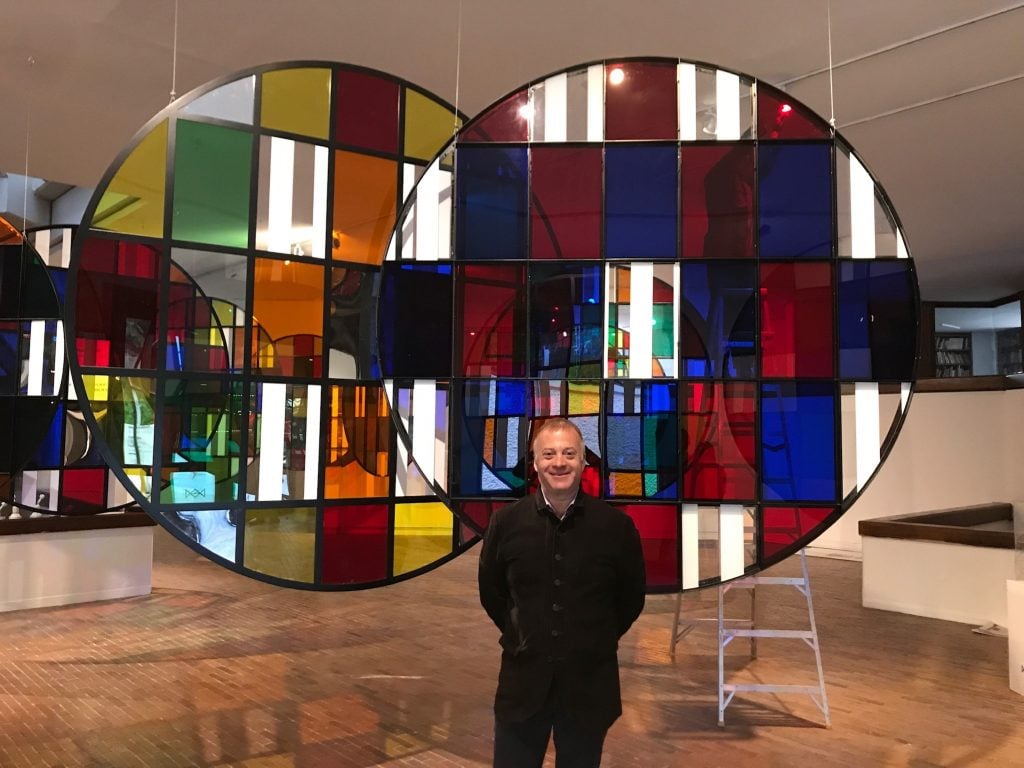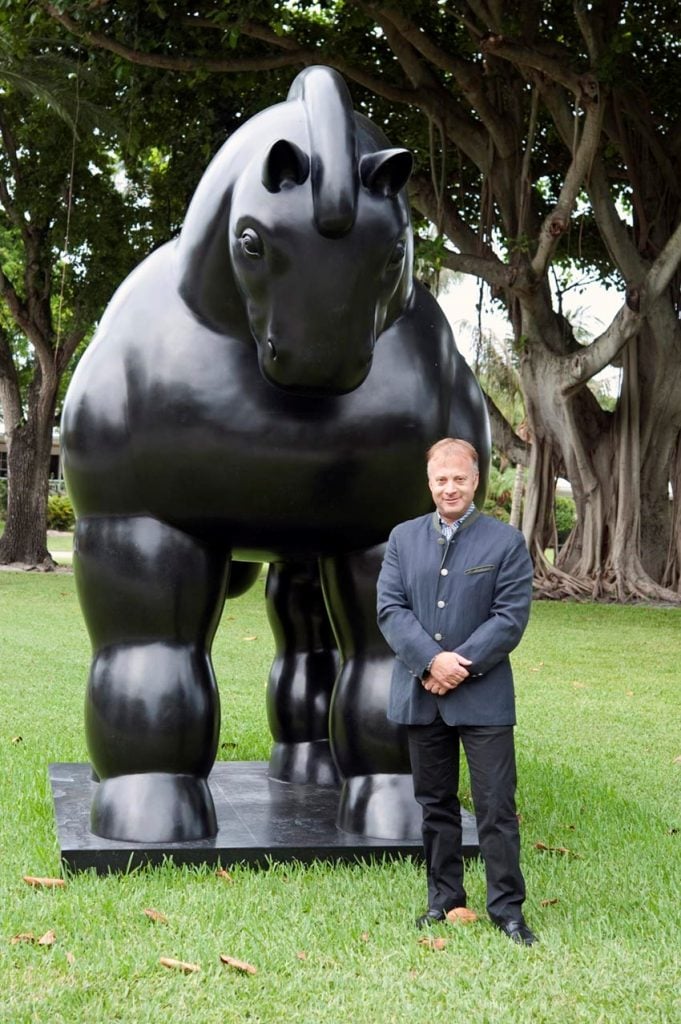Gallery Network
7 Questions for Dealer Felipe Grimberg on His Long Friendship With Fernando Botero to His Words of Warning for Young Gallerists
The dealer is currently working on his second book about Botero.

The dealer is currently working on his second book about Botero.

In his decades living between his native Bogotá and his adopted home of Miami, art dealer Felipe Grimberg has accumulated a cocktail story or two—from his childhood in Colombia to his friendship with Fernando Botero. He recounted a number of these tales in his book Selling Botero, published in 2015.
Now, with more than 30 years of art dealing under his belt, Grimberg is continuing where he left off with his second book, Botero 500. The founder of Miami’s Felipe Grimberg Fine Art, Grimberg is working at the height of his career. As his forthcoming book’s title suggests, Grimberg has now sold more than 500 works by Botero. He is also a collector with an impressive personal collection of contemporary art.
Recently, we spoke with Grimberg about his storied career, the works that got away, and his words of wisdom—and warning—for aspiring art dealers.

Felipe Grimberg with a sculpture by Fernando Botero.
Tell me about your journey. How and why did you become an art dealer? What led you to where you are today?
My first inklings about art and the art world were very much a family affair. Several times a year we would visit a relative’s house that was literally crammed with art. The walls were covered, and sculptures dotted the house and grounds. Turned out, she was one of the first real collectors of Colombian art in the ’60s and ’70s. I was sold. I loved admiring art, eavesdropping on the passionate conversations around art, and observing people enjoying and critiquing art. I knew then and there that art would always be the driver of my life.
I was a teenager when I asked my father to buy art for our residence and I envisioned myself building art collections in a beautiful setting. When I became more aware of the economic realities of life, I started selling and buying art from home. Life told me it was the right choice. It runs in my blood. I managed a couple of my father’s clients’ stores, hawked t-shirts, and even sold shrimp from a local fish farm to local restaurants.
So that is the beginning, and what has led me to where I am today. I realize how privileged this sounds but, believe me, it has been a long road with ups and downs. Nevertheless, I have woken up every day with a smile. Because I go to work being absorbed by a world of artists and carried along by a tidal wave of fortunate connections and people to whom I am introduced. I was and still feel like a perpetual scouter for referrals, and always on the lookout for collectors willing to buy or sell. At the same time, I diligently maintain the relationships formed over so many years. Many of these connections have evolved, I am happy to say, into true friendships.
What are the major lessons you’ve learned in art dealing over the past 35 years? What advice would you give your younger self?
Given the story I’ve just told you, the obvious answer is to always follow your passion. But I would certainly include a warning: Make sure you always keep an eye on how the world is changing. We have seen the evolution from collecting art into investing in art. We have seen how art becomes a commodity traded by the wealthy few. We have seen the evolution of the trade from galleries to digital shows. It is imperative for the younger me to be aware that the change is part of the world and that you always must have your finger on the pulse.
You relocated from Bogotá to Miami in 2000. Why? How has Miami transformed over the past 22 years?
I relocated to Miami as a private art dealer. The biggest driver of the move was that Miami was fast becoming the crossroads between North and Latin America in terms of art. I felt like a pioneer, a trailblazer, making a small contribution to the development of Miami as an important art hub and, at the same time, introducing my fellow countrymen to art and artists that were climbing the ladder here in the U.S. It was exhilarating and so much fun.
In Miami, I felt like a puppeteer working the strings behind the curtain. I toiled quietly and ethically behind the scenes, often calling in other partners who trusted my council, to help me make purchases. I wasn’t exactly raking in the money with my small markups, but my clients were thrilled to get access to the works of internationally famous artists. Miami has certainly grown up. It has also grown on me. I feel I am a different person now than I would have been, had I stayed in Bogotá. Being in Miami places you on the map in the art world. Certainly, it is not New York, Paris, or London, but for me, someone who is constantly building bridges with Latin America, it is the ideal place to evolve my business.
Over the years, has there been an artwork that was particularly hard to let go of?
There were two works by Jean-Michel Basquiat that I bought together with two investors. We paid a total of $814,000 for the two works: Quality Meats for the Public and Arroz Con Pollo. They were loaned to the Whitney Museum in New York for Basquiat’s retrospective. One of the partners lost faith in Basquiat’s prospects so we sold them at a loss. Today each of these pieces would be around $35 million. I know that sounds like it’s all about money. But you must have a look at the pieces. They are beautiful.
What has been your most memorable experience in the art world?
The memories of the first artworks I got to own as a young boy in Colombia. And, in 2004, when I brought Sir Dennis Mahon to the Prado Museum to verify the provenance of a Caravaggio that a client had brought to me. The stakes were high although the outcome was devastating to the value of the piece in question. The total experience of seeing Sir Dennis in action, combined with the use of advanced technology to determine the origin of a piece was unbelievable.
And last but not least, the unbelievable privilege of all the moments I have had over the years to be around Fernando Botero. There is no more fascinating character to be around. The way he speaks, his European demeanor, and his incredible discipline in his work and in public. Visiting Pietrasanta, where he works with his foundries during the summer, is certainly high up on the list of memorable experiences.
In 2015, you published your book Selling Botero, which delves into your career and relationship with Botero. Can you tell me about the book and your relationship with the artist?
Selling Botero is the story of my journey as a private art dealer and the deep passion for art that has carried me through life. The thread that runs through the book is my pursuit of Botero’s work and the relationship I was able to develop with him. It was a rollercoaster ride like no other. My relationship with him as a dealer, as a formidable role model in the world of international art, and, at last as a friend. The book is about that journey. Now at the age of 90, Botero is at the culmination of his achievements, recently setting a world record for one of his monumental statues at Sotheby’s. I am currently working on a second installment on the same theme. It is called Botero 500. As the title suggests I have now sold well over 500 works by Botero. I am honored to be his friend and will continue to deal and promote his work.
You also have an expansive personal collection. What was the first work you purchased?
Growing up in Colombia and being surrounded by the local scene, it is not surprising that my first purchases were Colombian artists in the 1980s. To name a few: Alfredo Guerrero, Maria De La Paz Jaramillo, Fernando Botero, Lorenzo Jaramillo, Dario Morales, and Enrique Grau.
What was the most expensive addition to your collection?
As you would expect, the most expensive was a Botero from 1964, Madame Rubens, that I bought at auction in 1987 for $50,000. That was a lot of money in 1987. But I remember it vividly.
Is there a work or two you consider the highlights of your collection?
A work by Sean Scully and, more recently, works by Eddie Martinez and Katharina Grosse.
If you could own any work of art in the world, what would it be?
It would be Luncheon of the Boating Party by Pierre-August Renoir, currently at the Phillips Collection in Washington, D.C.